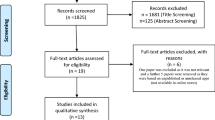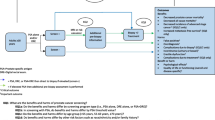Abstract
Purpose
The use of mobile phone applications (Apps) has modernised the conventional practice of medicine. The diagnostic ability of the current Apps in prostate specific antigen monitoring, and its diagnostic ability within prostate cancer (PCa) risk calculators have not yet been appraised. We aimed to review, rate and assess the everyday functionality, and utility of all the currently available PCa risk calculator Apps.
Methods
A systematic search on iTunes, Google Play Store, Blackberry World and Windows Apps Store, was performed on 23/11/2017, using the search term ‘prostate cancer risk calculator’. After applying the exclusion criteria, each App was individually assessed and rated using pre-set criteria and grading was performed using the validated uMARS scale.
Results
In total, 83 Apps were retrieved. After applying our exclusion criteria, only 9 Apps were relevant, with 2 duplicated, and the remaining 7 were suitable for critical review. Data sizes ranged from 414 kb to 10.1 Mb. The cost of the Apps ranged from South African rand (ZAR) 0.00 to ZAR 29.99. The overall mean category uMARS scores ranged from 2.8/5 to 4.5/5. Apps such as Rotterdam Prostate Cancer Risk Calculator, Coral—Prostate Cancer Nomogram Calculator and CPC Risk Calculator, performed the best.
Conclusions
The current PCa risk calculator mobile Apps available may be beneficial in counselling the concerned at risk patient. These Apps have potential to assist both the patient and the urologist alike. The PCa risk calculator App ‘predictability’ may be further enhanced by the incorporation of newly validated risk factors and predictors for PCa.


Similar content being viewed by others
References
Ferlay J, Soerjomataram I, Dikshit R, Eser S, Mathers C, Rebelo M et al (2015) Cancer incidence and mortality worldwide: sources, methods and major patterns in GLOBOCAN 2012. Int J Cancer 136:E359–E386. https://doi.org/10.1002/ijc.29210
Roobol MJ, Verbeek JF, van der Kwast T, Kümmerlin IP, Kweldam CF, van Leenders GJ (2017) Improving the Rotterdam European Randomized Study of Screening for Prostate Cancer risk calculator for initial prostate biopsy by incorporating the 2014 International Society of Urological Pathology Gleason grading and cribriform growth. Eur Urol 72(1):45–51. https://doi.org/10.1016/j.eururo.2017.01.033 (Epub 2017 Feb 2)
Foley R, Maweni R, Gorman L, Murphy K, Lundon D, Durkan G et al (2016) European Randomized Study of Screening for Prostate Cancer (ERSPC) risk calculators significantly outperform the Prostate Cancer Prevention Trial (PCPT) 2.0 in the prediction of prostate cancer: a multi-institutional study. BJU Int 118:706–713
Poyet C, Wettstein M, Lundon D, Bhindi B, Kulkarni G, Saba K et al (2016) External evaluation of a novel prostate cancer risk calculator (ProstateCheck) based on data from the Swiss arm of the ERSPC. J Urol 196:1402–1407
Jeong CW, Lee S, Jung J, Ki Lee B, Jeong S, Hong S et al (2014) Mobile application-base Seoul National University Prostate Cancer Risk Calculator: development, validation, and comparative analysis with two western risk calculators in Korean men. PLoS ONE 9(4):e94441. https://doi.org/10.1371/journal.pone.0094441
Myint M, Adam A, Herath S, Smith G (2016) Mobile phone applications in management of Enuresis: the good, the bad and the unreliable! J Pediatr Urol 12(2):112.e1-6. https://doi.org/10.1016/j.jpurol.2015.09.011 (Epub 2 Nov 2015)
Stoyanov S, Hides L, Kavanagh D, Wilson H (2016) Development and validation of the user version of the Mobile Application Rating Scale (uMARS). JMIR mHealth uHealth 4(2):e2
The European Randomised Study of Screening for Prostate Cancer (ERSPC). http://www.erspc.org/. Accessed 20 Aug 2017
Cooperberg MR, Hilton JF, Carroll PR (2011) The CAPRA-S score: a straightforward tool for improved prediction of outcomes after radical prostatectomy. Cancer 117(22):5039–5046
Nardozza Junior A, Fihlo M, Borges dos Reis R (2006) Antigeno Prostatico Especificio. In: Urologica fundamental, edition, 1st edn, pp 190–194
Karakiewicz PI, Benayoun S, Kattan MW, Perrotte P, Valiquette LU, Scardino PT et al (2005) Development and validation of a nomogram predicting the outcome of prostate biopsy based on patient age, digital rectal examination and serum prostate specific antigen. J Urol 173(6):1930–1934
Prostate Cancer Prevention Trial risk calculator version (PCPT) 2.0. http://myprostatecancerrisk.com/. Accessed 20 Aug 2017
Røder MA, Berg KD, Loft MD, Thomsen FB, Ferrari M, Kurbegovic S, Rytgaard HC, Gruschy L, Brasso K, Gerds TA, Kjær A (2016) The CPC risk calculator: a new app to predict prostate-specific antigen recurrence during follow-up after radical prostatectomy. Eur Urol Focus. https://doi.org/10.1016/j.euf.2016.11.014 (Epub ahead of print)
Yuri P, Wangge G, Abshari F, Satjakoesoemah AI, Perdana NR, Wijaya CD et al (2015) Indonesian prostate cancer risk calculator (IPCRC): an application for predicting prostate cancer risk (a multicenter study). Acta Med Indones 47(95):e103
Bender JL, Yue RYK, To MJ, Deacken L, Jadad AR (2013) A lot of action, but not in the right direction: systematic review and content analysis of smartphone applications for the prevention, detection, and management of cancer. J Med Internet Res 15(12):e287. https://doi.org/10.2196/jmir.2661
Collado-Borrell R, Escudero-Vilaplana V, Ribed-Sanchez A, Ibanez-Garcia S, Herranz-Alonso A, Sanjurjo-Saez M (2016) Smartphone applications for cancer patients; what we know about them? Farm Hosp 40(1):25–35
Kim H, Powell M, Bhuyan S (2017) Seeking medical information using mobile apps and the internet: are family caregivers different from the general public? J Med Syst 41:38
Ribeiro N, Moreira L, Barros A, Almeida A, Santos-Silva F (2016) Guidelines for a cancer prevention smartphone application: a mixed-methods study. Int J Med Inform 94:134–142
Adam A, Spencer K, Sivsankar P, Moon S, Jacub I (2016) Smartphone, Smart Surgeon, what about a ‘Smart Logbook’? S Afr J Surg 54(2):36–42
Hemminki K (2012) Familial risk and familial survival in prostate cancer. World J Urol 30(2):143–148
Mondul AM, Weinstein SJ, Albanes D (2017) Vitamins, metabolomics, and prostate cancer. World J Urol 35(6):883–893
MacInnis RJ, English DR, Gertig DM, Hopper JL, Giles GG (2003) Body size and composition and prostate cancer risk. Cancer Epidemiol Biomark Prev 12(12):1417–1421
Peisch SF, Van Blarigan EL, Chan JM, Stampfer MJ, Kenfield SA (2017) Prostate cancer progression and mortality: a review of diet and lifestyle factors. World J Urol 35(6):867–874
Lawrentschuk N, Abouassaly R, Hackett N, Groll R, Fleshner NE (2009) Health information quality on the internet in urological oncology: a multilingual longitudinal evaluation. Urology 74(5):1058–1063
Acknowledgements
The authors are grateful to Mrs. Anna Welman, Department of Surgery, Helen Joseph Hospital, University of Witwatersrand, Johannesburg, for her secretarial support in the drafting of this manuscript.
Author information
Authors and Affiliations
Contributions
AA: study inception, project development, grading-tool selection, grading, outline and structure, manuscript writing, editing, collaboration, submission, correspondence JCH: data collation, grading, manuscript writing/editing, MP: manuscript writing/editing, DB: manuscript writing/editing, NL: manuscript writing/editing.
Corresponding author
Ethics declarations
Conflict of interest
The authors declare that they have no conflict of interest.
Funding
A. Adam is not a recipient of a research scholarship.
Electronic supplementary material
Below is the link to the electronic supplementary material.
345_2017_2150_MOESM1_ESM.pdf
Supplementary file The uMARS appendix scoring sheet [7] (PDF 52 kb)
Rights and permissions
About this article
Cite this article
Adam, A., Hellig, J.C., Perera, M. et al. ‘Prostate Cancer Risk Calculator’ mobile applications (Apps): a systematic review and scoring using the validated user version of the Mobile Application Rating Scale (uMARS). World J Urol 36, 565–573 (2018). https://doi.org/10.1007/s00345-017-2150-1
Received:
Accepted:
Published:
Issue Date:
DOI: https://doi.org/10.1007/s00345-017-2150-1




